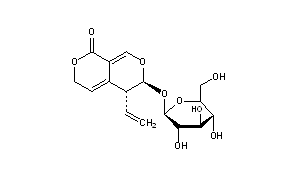Iridoids
Generally, Iridoids are known as pseudo-glycoside because it forms on combination of terpenoid and glycoside.
There common variety of animals and dicotyledon plant belonging to family Rubiaceae and Perpherbiaceae.
Some plants belonging to family Scrophulariaceae also contain iridoids.
Mostly all cardiac glycosides are in family Scrophulariaceae.
The Iridoids were named after end of ants from which they were isolated and involved in defensive mechanism of the insects.
Classification of iridoids:
- Iridoid glycosides
- Secoiridoid
- Non-glycosides compounds
Gentian
Gentian is dried partially fermented rhizomes and roots of plant Yellow Gentian i.e. Gentiana lutea.
Yellow Gentian, Gall weed, Bitter wart , Radix Gentianae.
Synonyms:
- Gentian root,
- Gentania,
- Radix,
- Yellow Gentian (पीला जेंटियन) – Hindi,
Biological Source:
Gentian is dried partially fermented rhizomes and roots of plant Yellow Gentian i.e. Gentiana lutea. Family – Gentianaceae.
Geographical Source:
Mountanious regions of Central and south Europe, of France and Switzerland, of Spain and Portugal, the Pyr-enees, Sardinia and Corsica, the Apennines, the Mountains of Auvergne, the Jura, the lower slopes of the Vosges, the Black Forest and throughout the chain of the Alps as far as Bosnia and the Balkan States.
Morphology/Macroscopics Characters:
- Color: Yellowish-brown
- Odour: Sweet
- Taste: First gives sweet, followed by intensive bitter.
- Fracture: short and smooth but become tough and flexible when moist.
Microscopic Character:
The transverse section of rhizome shows bark cambium, wood and pith. The root shows these parts but pith does not shows these parts. In place of which a tri-arc primary xylem is present.The cork cell are thin walled and cortex has parenchyma with oil globule and calcium ocalate crystals.
Chemical Constituents:
Chemical Tests:
- Alcoholic extract of drug appears light blue fluorescence in UV light.
Uses:
- Used as an herbal bitter in the treatment of digestive disorders.
- Used as a scientific basis for measuring bitterness.
- Useful in states of exhaustion from chronic disease and in all cases of debility, weakness of the digestive system and lack of appetite.
- Best strengthened of the human system, stimulating the liver, gall bladder and digestive system, and is an excellent tonic to combine with a purgative in order to prevent its debilitating effects.
- Used as anthelmintic, antiinflammatory, antiseptic, bitter tonic, cholagogue, emmenagogue, and febrifuge, refrigerant and stomachic.
- Taken internally in the treatment of liver complaints, indigestion, gastric infections and anorexia. It should not be prescribed for patients with gastric or duodenal ulcers.

